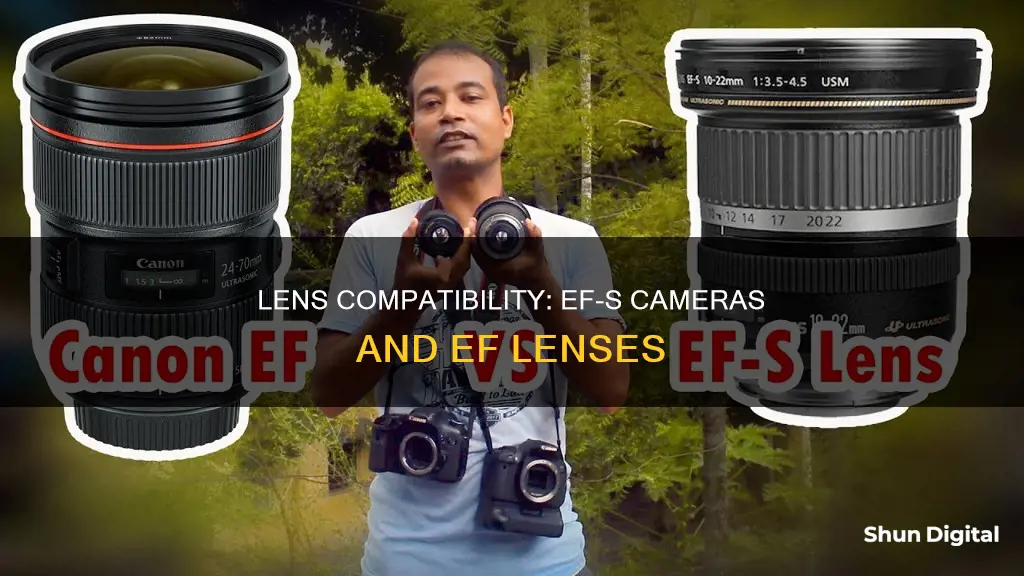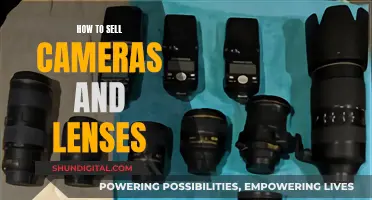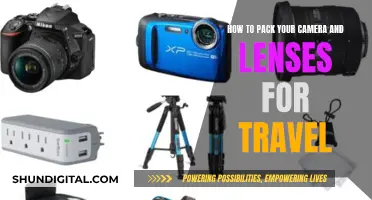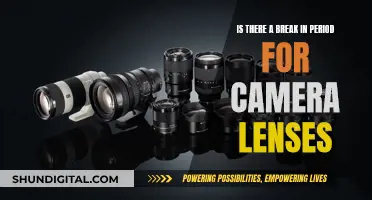
Canon EF and EF-S lenses refer to the mount type of the lens, which also differentiates between the sensor type. Canon EF lenses are designed to work with full-frame and APS-C DSLRs, whereas Canon EF-S lenses are designed solely for use on Canon APS-C DSLRs. Canon EF-S lenses have a smaller image circle, which is only large enough to cover the smaller sensor found on Canon APS-C cameras. Canon EF lenses, on the other hand, have a larger image circle and will cover full-frame sensors and APS-C sensors.
| Characteristics | Values |
|---|---|
| EF lenses introduced | 1987 |
| EF-S lenses introduced | 2003 |
| EF lenses | Designed for full-frame DSLRs |
| EF-S lenses | Designed for APS-C DSLRs |
| EF lenses | Work with full-frame and APS-C DSLRs |
| EF-S lenses | Do not work with full-frame DSLRs |
| EF-S lenses | Are smaller and lighter than EF lenses |
| EF-S lenses | Are more affordable than EF lenses |
| EF-S lenses | Are not considered "professional" lenses |
| EF-S lenses | Are made with lower-grade materials |
| EF-S lenses | Are less expensive to manufacture |
| EF-S lenses | Are more popular among amateur photographers |
What You'll Learn
- Canon EF lenses are compatible with both full-frame and APS-C Canon cameras
- Canon EF-S lenses are only compatible with APS-C Canon cameras
- Canon EF lenses are bigger and have a larger image circle than EF-S lenses
- Canon EF-S lenses are more affordable, compact, and lightweight than EF lenses
- Canon EF lenses are designed for professionals, while EF-S lenses are designed for amateur photographers

Canon EF lenses are compatible with both full-frame and APS-C Canon cameras
Canon EF lenses are produced for full-frame DSLRs and are designed to cover a 35mm film frame. They have a larger image circle, so they will cover full-frame sensors and APS-C sensors.
Canon EF-S lenses, on the other hand, are designed to fit the smaller APS-C Canon "crop" cameras. They have a smaller image circle and are not compatible with full-frame cameras.
While EF-S lenses are not compatible with full-frame cameras, EF lenses are compatible with APS-C cameras. This means that if you have an APS-C camera, you can use either EF or EF-S lenses.
The "S" in EF-S stands for "Small image circle" or "Short back focus". The smaller image circle of EF-S lenses means that they project a smaller image to match the sensor size of APS-C cameras. The shorter back focus allows the lens elements to be closer to the sensor, which is possible due to the smaller mirror used in APS-C cameras.
The combination of a smaller sensor and shorter back focal length distance in EF-S lenses enhances the possibilities for wide-angle lenses. EF-S lenses can be made smaller, lighter, faster, and less expensive.
However, it is important to note that EF-S lenses cannot be mounted on DSLRs with sensors larger than APS-C. Mounting an EF-S lens on a full-frame camera will result in heavy vignetting as the image circle is not large enough to cover the full-frame sensor.
In summary, Canon EF lenses are compatible with both full-frame and APS-C Canon cameras, while EF-S lenses are only compatible with APS-C Canon cameras.
Do Contact Lenses with Camera Exist?
You may want to see also

Canon EF-S lenses are only compatible with APS-C Canon cameras
Canon EF-S lenses are designed solely for use on Canon APS-C DSLRs. Canon EF lenses, on the other hand, are designed to work with both full-frame and APS-C DSLRs from Canon.
The "S" in Canon EF-S stands for "Small image circle" or "Short back focus". The EF-S lenses have a smaller image circle and are made to fit the smaller APS-C Canon "crop" cameras. Canon EF lenses, in contrast, have a larger image circle and are made to work with full-frame APS Canons.
While it is possible to use an EF lens on a smaller APS-C camera, the reverse is not true. Canon EF-S lenses do not work with full-frame Canon cameras. The image circle of an EF-S lens is not large enough to cover the entire full-frame sensor, resulting in heavy vignetting if used on a full-frame DSLR.
Only Canon cameras released after 2003 with APS-C sized sensors support the EF-S mount.
Action Cameras: Fisheye Lenses and Their Uses
You may want to see also

Canon EF lenses are bigger and have a larger image circle than EF-S lenses
Canon EF-S lenses, on the other hand, were created specifically for Canon digital single-lens reflex cameras with APS-C-sized image sensors and released in 2003. The "S" in EF-S stands for "Small image circle" or "Short back focus". The EF-S lenses have a smaller image circle that matches the smaller sensor found in Canon APS-C cameras. Due to their smaller image circle, EF-S lenses cannot be mounted on DSLRs with sensors larger than APS-C.
The larger image circle of Canon EF lenses allows them to cover both full-frame and APS-C sensors. This makes EF lenses compatible with a wider range of Canon cameras, including both full-frame and APS-C DSLRs. In contrast, EF-S lenses are designed solely for use with Canon APS-C DSLRs.
The physical size difference between EF and EF-S lenses is also notable. EF-S lenses are generally smaller and lighter than EF lenses because they require less glass and a smaller lens barrel to produce an equivalent field of view for APS-C cameras. This makes EF-S lenses more affordable and popular among amateur photographers.
Lens Identification: Serial Numbers on Camera Lenses
You may want to see also

Canon EF-S lenses are more affordable, compact, and lightweight than EF lenses
EF-S lenses are a great option for photographers using APS-C cameras who want a more affordable and compact lens. The smaller size and weight of EF-S lenses make them easier to carry around and balance better with smaller cameras. The shorter back focal length distance also enhances the possibilities for wide-angle lenses, allowing for wider angle and very wide-angle lenses.
In addition to being more affordable and compact, EF-S lenses also offer some optical advantages over EF lenses when used on APS-C cameras. The smaller image circle of EF-S lenses matches the smaller sensor size of APS-C cameras, resulting in reduced vignetting and improved image quality. The shorter back focal length distance allows the lens elements to protrude further into the camera body, reducing the minimum distance between the sensor and the back element of the lens. This design enhances the possibilities for wide-angle lenses and can improve image quality in some situations.
While EF-S lenses offer many benefits, it is important to note that they are not compatible with all Canon cameras. They are designed specifically for APS-C cameras and cannot be used on full-frame EF-only cameras. Additionally, not all Canon APS-C cameras support EF-S lenses; only those released after 2003 with APS-C sized sensors are compatible.
Camera Lenses: Waterproof or Not?
You may want to see also

Canon EF lenses are designed for professionals, while EF-S lenses are designed for amateur photographers
The Canon EF lens mount was introduced in 1987 with the launch of the EOS system, marking the start of the single biggest native lens system for an interchangeable lens camera. Canon EF lenses are known for their autofocusing capabilities, with a dedicated electric motor built into the lens for automatic focusing. This innovation allows for autofocusing lenses without the need for mechanical levers in the mount mechanism. The EF series includes over eighty lenses, offering various focal lengths, advanced features, and compatibility with newer Canon bodies.
On the other hand, Canon EF-S lenses are designed for APS-C sensor cameras and were released in 2003. These lenses are popular among amateur photographers due to their lower cost and the preference for zoom lenses over prime lenses. EF-S lenses are generally smaller, lighter, faster, and less expensive than their EF counterparts. They are also known for enhancing the possibilities for wide-angle and very wide-angle lenses.
While EF-S lenses are designed for APS-C sensor cameras, they are backward compatible with EF lens mounts. This means that EF-S lenses can be used on Canon cameras released after 2003 with APS-C-sized sensors. However, it is physically impossible to mount EF-S lenses on EF-only cameras due to the increased proximity of the lens to the sensor, which can cause damage to the lens and camera.
In summary, Canon EF lenses cater to professionals with their advanced features, autofocusing capabilities, and compatibility with a wide range of Canon camera bodies. On the other hand, Canon EF-S lenses are designed for amateur photographers, offering a cost-effective option with enhanced capabilities for wide-angle photography. The compatibility of EF-S lenses with specific Canon camera models underscores their target audience of amateur photographers.
Stabilization in Camera Lenses: How Does It Work?
You may want to see also
Frequently asked questions
EF lenses are produced for Canon's full-frame DSLRs and EF-S lenses are produced for Canon's APS-C DSLRs. EF lenses have a larger image circle and are bigger, whereas EF-S lenses have a smaller image circle and are made to fit the smaller APS-C Canon "crop" cameras.
Yes, you can use EF lenses on EF-S mount cameras. Canon EF lenses are compatible with both full-frame and APS-C DSLRs from Canon.
No, you cannot use EF-S lenses on full-frame cameras. EF-S lenses have a smaller image circle that is only big enough to cover the smaller sensor found on Canon APS-C cameras. If an EF-S lens is used on a full-frame camera, it will produce heavy vignetting as the image circle will not be large enough to cover the larger sensor.







